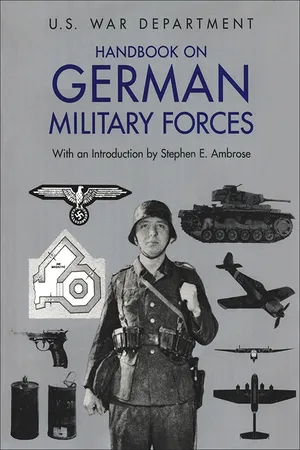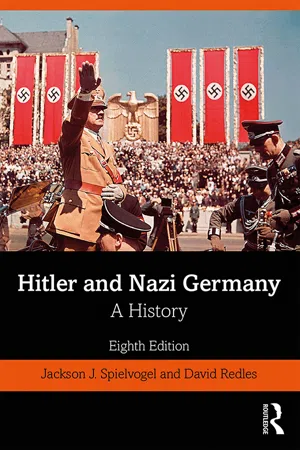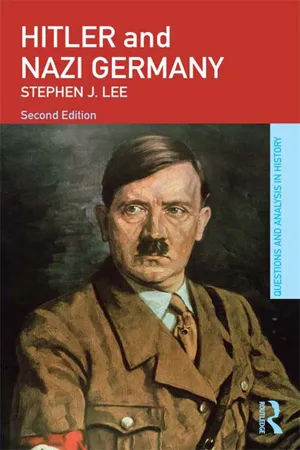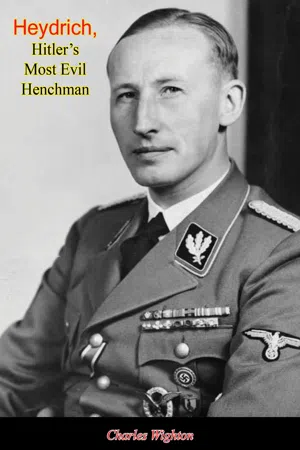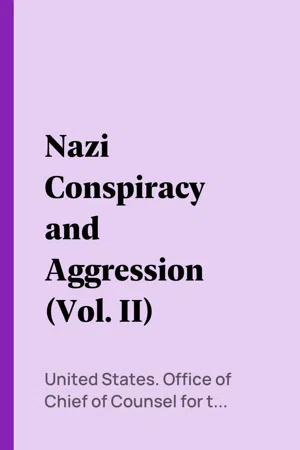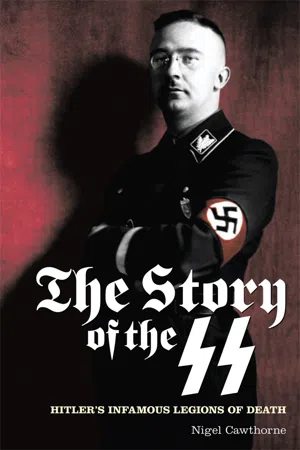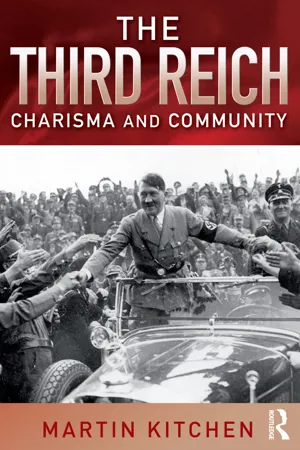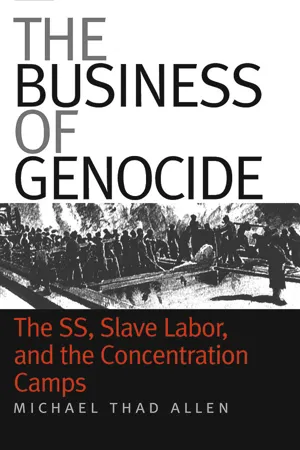History
The SS
The SS, or Schutzstaffel, was a paramilitary organization that served as the elite guard of the Nazi Party and Adolf Hitler. It was responsible for many war crimes and atrocities during World War II, including the Holocaust. The SS was disbanded after Germany's defeat in 1945.
Written by Perlego with AI-assistance
Related key terms
1 of 4
Related key terms
1 of 3
11 Key excerpts on "The SS"
- eBook - ePub
- David I. Norwood, David I. Norwood(Authors)
- 1990(Publication Date)
- LSU Press(Publisher)
CHAPTER IIIOTHER MILITARY AND AUXILIARY ORGANIZATIONS
Section I. SS AND POLICE
I. Introduction
Any description of organization, mission, and structure of the SS cannot be understood unless one tries to conceive it inwardly with one’s blood and heart. It cannot be explained why we contain so much strength though we number so few.Heinrich Himmler.The SS, or Schutzstaffel, is the Protective Guard of the National-Socialist Party (NSDAP). Officially an independent Gliederung (Branch) of the Party, led by Heinrich Himmler, it actually has a status and importance far exceeding those of the other branches and even those of the Party itself. From its original function of guarding the person of Party leaders and speakers, the SS developed even before the war, into a far-flung organization to protect the entire Nazi movement against all internal enemies. More recently, it has extended its influence anc. power into every conceivable aspect of German national life and has finally acquired a large measure of control over the Army itself. It is more than a state within a state; it is superior to both the Party and the government.The rise of the SS has been gradual but unceasing. Because of its origin and its own experience as an underground organization, it has always understood how to combat systematically and unrelentingly any subversive activities in the Reich and in all occupied areas. It was by extension of its responsibility for internal political security that the SS first acquired control of the Secret State Police and la:er (in 1936) of the entire police forces of Germany. Quite naturally therefore, it was given the policing powers in most of the countries occupied by Germany during the war. It was also logical that the SS, as the elite corps of the Party, should take part in the march into Austria and Czechoslovakia along with the troops of the Army, and that it should furnish small contingents of trained men to fight in the Polish campaign in 1939. This led to the building up of the Waffen-SS, at first consisting of the equivalent of two or three divisions and finally growing to a substantial and favored branch of the armed forces of the nation. In 1943 the SS gained control of the powerful Ministry of the Interior, in which it had already constituted the most important group in the form of the police. During 1943 and 1944 the SS - eBook - ePub
Hitler's Followers (RLE Nazi Germany & Holocaust)
Studies in the Sociology of the Nazi Movement
- Detlef Muhlberger(Author)
- 2014(Publication Date)
- Routledge(Publisher)
7The SS
Along with the SA, from which it was to recruit many of its members before 1933, The SS was one of the oldest Nazi specialist organizations by the time of the Nazi seizure of power.1 The SS emerged in 1925 when Hitler ordered the creation of a Stabswache (Staff Guard) to act as his personal bodyguard and to protect the party leadership in general, a task assigned by him to Julius Schreck in April 1925. The Staff Guard recruited by Schreck, which made its first public appearance in Munich on 16 April 1925 at the funeral of Ernst Pöhner, was essentially the successor of the Stosstrupp Hitler which had existed briefly in 1923,2 a formation in which Schreck and many members of the new Stabswache had formerly been active, and one from which the new Staff Guard also copied its death’s head insignia. It was this Munich organization which was re-christened Schutzstaffel , a term also applied to similar formations which gradually emerged in various other localities in Germany by the autumn of 1925. Conceived very much as an ‘elite’ organization within the Nazi Movement, Schreck and his successor Josef Berchtold, who took over The SS on 15 April 1926, recruited the more active and reliable party members (initially only those between 23 and 35 years of age), who were charged with the protection of the movement and its meetings, as well as with furthering the propaganda activities of the party. These tasks were virtually identical with those of the SA, to which the fledgeling organization was subordinated following the appointment of Franz Pfeffer von Salomon as ‘Supreme SA Leader’ on 1 November 1926. For much of the late 1920s The SS grew only very slowly in the shadow of the SA. There is some uncertainty as to the actual size of The SS in the years immediately following its formation. It is estimated that the organization had enrolled around 800 men by the end of 1925, its total strength rising to about 1,000 by the end of 1928, reaching the 2,000-mark by the end of 1929 and a strength of 2,727 by the end of 1930.3 According to statistics furnished by the Nazis themselves (and these included a small number of Austrian SS members), it was only in the course of 1931 – two years after the appointment of Heinrich Himmler as Reichsführer-SS – that The SS began to grow in size, a beneficiary of the general expansion of the Nazi Movement in the early 1930s, with a strength of 14,964 by the end of 1931, rising to 52,048 by the end of 1932. A membership spurt in 1933 following Hitler’s elevation to the chancellorship took its total strength to 209,014 by 31 December.4 - eBook - ePub
Hitler and Nazi Germany
A History
- Jackson J. Spielvogel, David Redles(Authors)
- 2020(Publication Date)
- Routledge(Publisher)
Kristallnacht the expulsion of Jews from Germany was accelerated. A Reich Central Office for Jewish Emigration was established under Reinhard Heydrich, head of the Security Service (SD) branch of The SS. Its object was to promote the “emigration” of Jews from Germany. The SS, whose racial policy favored complete expulsion of the Jews, vigorously pursued forced emigration. Even after the outbreak of war in September 1939, emigration was still the policy. The most ambitious project of 1940, after the defeat of France, was the Madagascar Plan, which aimed at the mass shipment of Jews to an island off the east coast of Africa. But this plan was never seriously considered, and the policy of emigration was soon replaced by a more gruesome one as the war severely radicalized the situation.Instrument of Terror: The SS Police State
To win Germans over to the sense of community embodied in their conception of the Volksgemeinschaft , and to justify and perpetrate its anti-Jewish policies, the Nazis expended considerable effort in propaganda and indoctrination. For many Germans, this was sufficient to make them willing participants in the new Nazi state. But Hitler and the Nazis did not rely only on verbal persuasion. From the beginning of the movement they counted on force and violence to achieve their goals. And so it was in their seizure of power. One party organization came to be the dominant symbol of the Nazi use of force and terror. The SS, with its black uniforms and death’s head insignia and all its various police organizations, struck fear into the hearts of those who either opposed the regime or would not be allowed to live in the new pure German state.Beginnings
The SS was established in 1925 with the formation of a small personal guards unit whose function was to protect Hitler and other party leaders. It was called the Schutzstaffeln - eBook - ePub
- Chris Bishop(Author)
- 2023(Publication Date)
- Amber Books Ltd(Publisher)
ORIGINS OF THE WAFFEN SST hey were the original ‘Men in Black’, the personification of the Nazi state. In their sombre uniforms adorned with swastikas and death’s heads, the members of the Schutzstaffeln, or SS, cast their shadow over Germany in the 1930s, and they grew in power during the war. Offering the Führer loyalty to the death, SS members were committed to National Socialism long after it became obvious that the Nazis were pulling Germany down into ruin.Even today, they have a curiously compelling image: black-clad Aryan supermen, executors of the Final Solution, the cruel and merciless soldiers of the Nazi state, who were armed with the latest weapons that Germany’s scientists and engineers could devise. Like many commonly held notions, this picture of The SS does not tell the whole story. The SS did wear black, but only in the pre-war years. SS men were responsible for some of the worst atrocities of the war – but they were also Germany’s toughest soldiers.Hitler’s SS bodyguard, the Leibstandarte, parades past its master on his birthday in 1939. Born out of a need for hard men to protect Nazi political meetings, The SS grew into an all-powerful state within a state.INSPIRED BY HITLERThe original shape and form of The SS owed much to Adolf Hitler. It was he who formed the specially selected bodyguard units that would evolve into The SS; gave them their sense of being chosen men; selected men who took pride in their unquestioning obedience and who would do anything he asked – whether legal or not.The origins of The SS date back to the early 1920s, when for the first time the National Socialist German Worker’s Party (NSDAP) was making its presence felt in the rough-and-tumble of Bavarian politics. Violence played a major part in the politics of the time, so a paramilitary wing was set up by the Nazis for street fighting. By the end of 1922, this had become the Sturmabteilung, - eBook - ePub
- Stephen J. Lee(Author)
- 2013(Publication Date)
- Routledge(Publisher)
Einsatzgrüppen, then in the main extermination camps at Auschwitz-Birkenau, Sobibor, Maidenek, Chelmo, Belzec and Treblinka. Meanwhile The SS had also infiltrated the entire political structure. By 1939 it was already a source of new Party functionaries and replenishing manpower in the key departments of State.All this has led some historians to believe that by 1941 the Nazi State had been transformed into an SS State. To the ‘functionalist/structuralist’ historians, this carried all the implications for the conflicts examined in Chapter 3 , Analysis 2 : in its competition with the other agencies, The SS contributed greatly to the chaos inherent within the polycratic system. By contrast, Bracher considers that The SS were perhaps the exception to the ‘intentionalist’ argument. Of all the agencies within the Third Reich, ‘Only The SS were able to develop an independent position as the avant-garde of the National Socialist empire’.4 Browder goes further: although Hitler ‘did not have to be persuaded to adopt a police-state system like the one Himmler offered’, he did have to abandon his customary principle of divide-and-rule and ‘to concentrate enormous powers in Himmler’s hands’.5There was, of course, still conflict between The SS on the one hand and State and Party functionaries on the other. But when these occurred, The SS usually got its way; indeed, it was the instrument chosen to implement key policies during the war years, even forcing the State and Party into line. This can be illustrated by the Wannsee Conference, held on 20 January 1942. Fully aware of tensions between The SS and government ministries, Reichsmarschall Goering instructed General Heydrich, effectively number two in The SS, to secure full cooperation in finding a ‘total solution of the Jewish question in the German sphere of influence in Europe’.6 - eBook - ePub
- Charles Wighton(Author)
- 2017(Publication Date)
- Arcole Publishing(Publisher)
CHAPTER THREE — IN The SS
The SS, like every other German institution ever devised, was a highly bureaucratic organization. Despite Himmler’s personal interest it took him almost a month to transfer his brilliant new recruit to The SS headquarters in Munich. In the interval Heydrich got his first taste of what membership of The SS meant. At Heydrich’s funeral, twelve years later, Himmler told how the former naval officer, an ordinary SS man in a tiny Hamburg SS platoon, fought with his comrades, chiefly unemployed youths, in the beer cellars and streets of the red light district of the great Hanseatic city.On 10 August Heydrich was posted officially to the Munich SS. At the same time he was commissioned with the rank of Sturmführer, or platoon leader. As the protégé of Heinrich Himmler promotion was rapid. At the beginning of December he was given The SS equivalent of his former substantive naval rank, SS Hauptsturmführer. Less than a month later, on Christmas Day—perhaps to mark the occasion of his wedding which took place twenty-four hours later—Heydrich was further promoted to the rank of Sturmbannführer, or major of The SS. At that time the Schutzstaffel numbered less than one thousand officers and men.The SS was originally founded around 1922, eighteen months or so before Hitler’s first abortive putsch in Munich. It was formed from the small group of strong-arm men whom Hitler had gathered around him in the first years of the Nazi Party and who acted variously as personal bodyguards, secretaries, chauffeurs—and chuckers-out at the turbulent Party meetings. At this time The SS was known as the “Adolf Hitler Shock Troops” and Hitler himself has given the best account of how The SS was founded:Being convinced that there are always circumstances in which élite troops are called for, in 1922-23 I created the Adolf Hitler Shock Troops. They were made up of men who were ready for revolution and who knew that some day events would come to hard knocks. When I came out of Landsberg [where Hitler was interned after the Munich putsch] everything was broken up and scattered—sometimes in rival hands. I told myself that I needed a bodyguard, even a very restricted one. But it had to be made up of men who would enlist without conditions, willing to march even against their brothers—only twenty of them to a city—and of absolute reliability rather than a doubtful mass. - eBook - ePub
- United States. Office of Chief of Counsel for the Prosecution of Axis Criminality(Author)
- 2017(Publication Date)
- Perlego(Publisher)
sic ] June 1934. Proof of the elite Nazi quality and thorough reliability of The SS, the test by which it won its spurs, occurred on 30 June 1934, when it participated in the purge of the SA and other opponents or potential opponents of the Nazi regime. That was the first real occasion for use of this specialized organization which could operate with the blessing of the Nazi State but outside the law. In an affidavit signed and sworn to in Nurnberg on 19 November 1945, Wilhelm Frick says, referring to the victims of that purge:Himmler referred to this same event in his Posen speech:“They were just killed on the spot. Many people were killed—I don’t know how many—who actually did not have anything to do with the putsch. People who just weren’t liked very well, as for instance, Schleicher, the former Reich Chancellor, were killed * * * The SS was used by Himmler for the execution of these orders to suppress the putsch.” (2950-PS )“Just as we did not hesitate on June 20,[sic ] 1934, to do the duty we were bidden, and stand comrades who had lapsed, up against the wall and shoot them, so we have never spoken about it and will never speak about it.” (1919-PS )It was in recognition of its services in this respect that The SS was elevated to the status of a component of the Party equal in rank to the SA and other similar branches. The following announcement appeared on page 1 of the Voelkischer Beobachter of 26 July 1934:“The Reich press office announces the following order of the Fuehrer. “In consideration of the greatly meritorious service of The SS, especially in connection with the events of 30 June 1934, I elevate it to the standing of an independent organization within the NSDAP.“Munch 20 July 1934.” (1857-PS )(2) Functions as a Repressive Police Organization.One of the first steps essential to the security of any regime is control of the police. The SS was the type of organization which the conspirators needed for this purpose. Their aim was to fuse The SS and police, and to merge them into a single, unified repressive force.Shortly after the seizure of power the conspirators began to develop as part of the state machinery, secret political police forces. These originated in Prussia with the Gestapo, established by decree of Goering in April 1933, and were duplicated in the other German States. (This development is discussed in Section 6 on the Gestapo.) By 1934 Himmler, the Reichsfuehrer SS, had become the chief of these secret political police forces in each of the German states except Prussia, and deputy chief of the Prussian Gestapo. In that capacity he infiltrated these forces with members of The SS until a virtual identity of membership was assured. - eBook - ePub
The Story of the SS
Hitler's Infamous Legions of Death
- Nigel Cawthorne(Author)
- 2012(Publication Date)
- Arcturus(Publisher)
Chapter Six
The SS- Allgemeine
The SS was reorganized after the creation of the SS-Verfügungstruppe (the combat arm) in 1934. The SS-Totenkopfverbände , which ran the concentration camps, stayed a separate unit. Opportunists, alcoholics, homosexuals and those of uncertain racial status were purged. Those that remained became the SS-Allgemeine (General SS), which soon thrust its claws into every part of German life.Following its reorganization in 1934, The SS comprised three separate forces: the SS-Allgemeine , the SS-Verfügungstruppe (SS-VT) and the SS-Totenkopfverbände . By 1938, SS-Allgemeine numbers had risen to 485,000.That figure was boosted by 50,000 when the SS-Totenkopfverbände , with the exception of the SS-Totenkopf Division, was merged into the SS-Allgemeine in May 1939.In 1935, the SS-Hauptamt (SS Head Office or SS-HA) controlled the concentration camps and The SS-VT, as well as the SS-Allgemeine . But The SS-VT expanded rapidly, becoming the Waffen-SS in 1940. The SS then needed an operational headquarters, so The SS-HA became an administrative office and The SS Leadership Main Office (SS-FHA) was created. Reporting directly to Himmler, it controlled the Command Department of the Waffen-SS and the Command Department of the SS-Allgemeine .Although the SS-Allgemeine could be described as the ‘General SS’, or the political wing of The SS, many of its members were called up into the Wehrmacht or the Waffen-SS as the war progressed.Only around 100,000 of its members, such as full-time officers and members of the various domestic departments of The SS, were exempt from military service. Part-time voluntary units were organized by region and district, each district containing a number of Standarten or regiments. Some districts even had Reiterstandarten – cavalry units.Diverse roles
The departments of the SS-Allgemeine - eBook - ePub
The Third Reich
Charisma and Community
- Martin Kitchen(Author)
- 2014(Publication Date)
- Routledge(Publisher)
Chapter 7 The SA, SS and Police The SST he brown-shirted Storm Section (SA) was founded on 3 August 1921. Organized by Captain Ernst Röhm, its officers came mostly from Captain Hermann Ehrhardt’s murderous gang Organisation Consul (OC), the rank and file from various paramilitary groups in Bavaria. It specialized in political murder, beating up anyone who dared heckle Hitler in his beer hall meetings, terrorizing the infant NSDAP’s opponents and parading truculently through the streets of Munich. The SA was closely associated with the local army (Reichswehr) units, which trained them in basic military skills. From the outset the SA was fiercely independent, resentful of any control by Hitler and the party. Hitler put Hermann Göring, a highly decorated air ace, in charge of the SA in 1923, hoping thereby to rein in Ehrhardt’s men, and selected a small gang of thugs as his personal bodyguards. Their uniform was field grey with black ski caps and a death’s head badge. Shortly thereafter Ehrhardt broke with Hitler and withdrew his men from the SA. Hitler renamed his bodyguard Adolf Hitler’s Raiders (Stosstrupp Adolf Hitler) and placed it under the command of Joseph Berchtold, a dwarfish stationer who was deputy party treasurer.The Stosstrupp was banned after the comic opera Hitler Putsch of November 1923 and Göring and Berchtold fled to Austria. While Hitler was in prison at Landsberg Ernst Röhm built up a new paramilitary organization on a national level called Vanguard (Frontbann) whose patron was Hitler’s co-conspirator, General Ludendorff. Röhm was determined to keep his organization completely separate from the party and was thus on a collision course with Hitler, who decided to found a rival organization that would be utterly loyal to him. In April 1925 he ordered his chauffeur, Julius Schreck, to recruit a bodyguard. Schreck found eight former members of the Stosstrupp in a Munich beer hall, Torbräu, and gave them the title Protection Squad (Schutzstaffel – - eBook - ePub
Reassessing the Nuremberg Military Tribunals
Transitional Justice, Trial Narratives, and Historiography
- Kim C. Priemel, Alexa Stiller, Kim C. Priemel, Alexa Stiller(Authors)
- 2012(Publication Date)
- Berghahn Books(Publisher)
In addition to twenty-two high-ranking officials of the Third Reich, the prosecution indicted various National Socialist organizations. These were accused of having been criminal associations. Each of these organizations had its own defense counsel. Three of these entities the tribunal did not find to be entirely criminal in the end: the Sturmabteilungen (SA or Storm Troopers), the Reich Government, and the Generalstab and the High Command of the Wehrmacht. 6 However, in their verdict, the four Allied judges declared the following entities to be criminal organizations: first, the corps of the political leaders of the Nazi Party; second, the Geheime Staatspolizei (Gestapo or Secret State Police) as well as The SS- Sicherheitsdienst (SD or Security Service), both of which had been under the supervision of Heinrich Himmler, Reich Leader of The SS; and third, The SS as a whole. The SS therefore was seen to have stood at the center of National Socialist criminality. There were some exceptions, notably the Reiter-SS (Mounted SS) and the Waffen SS conscripts who had joined in the later stages of the war. But overall, the verdict perceived The SS as the most heinous organization of National Socialist Germany. In this sense, the judges followed the prosecution’s lead. In his opening address at the beginning of the IMT, Robert H. Jackson, US Chief of Counsel, had already suggested that The SS belonged to “the worst of the [Nazi] movement.” 7 On November 21, 1945, he further pointed out that the majority of those who had worked for The SS had been both volunteers and ideologically committed to The SS goals: “Except for a late period when some compulsory recruiting was done in The SS, membership in all these militarized formations was voluntary - eBook - ePub
The Business of Genocide
The SS, Slave Labor, and the Concentration Camps
- Michael Thad Allen(Author)
- 2003(Publication Date)
- The University of North Carolina Press(Publisher)
The press also brought out novels in which heroes persevered by virtue of superior German culture and the Nordic race. The SS could have easily contracted with existing publishers, but Himmler conceived of The SS as a rescue organization for Germany’s cultural soul. This mission lay at the root of all SS institutions, including its budding industrial empire. Nordland promised to “bring The SS world view [ Weltanschauung ] to The SS membership and to the people,” a purpose too lofty, too important to trust to private industry. 23 Permutations of racism appear in the title of a Nordland anti-Soviet brochure, “The Subhuman” (Untermensch). 24 But racial supremacy was only one ideological current. One of the most pronounced values in SS entrepreneur-ship was its productivism, defined here as the belief that industrial and economic activity should be bent to the service of national identity rather than sordid profit gains. To The SS, the efflorescence of German culture, the forging of spirit—not the prosperity of citizens or economic utility—constituted the highest purpose of the factory. Therefore a strong, centralized state should seek to control industry in such a way as to preserve the sanctity of Germandom, a cause in which mere cost could not be allowed to set the ultimate bottom line. SS business managers would cling to this ideal even as the Third Reich began to crumble. An SS lawyer who later directed the acquisition of SS industries in occupied Poland even wrote a manifesto on this theme: Why does The SS pursue business? This question is thrown at us especially by those who think in purely capitalist terms and look unfavorably on public enterprise or at least on enterprises that have a public character. The time of liberal economics promoted the primacy of business. That is, first comes the economy and then the state
Index pages curate the most relevant extracts from our library of academic textbooks. They’ve been created using an in-house natural language model (NLM), each adding context and meaning to key research topics.
Explore more topic indexes
Explore more topic indexes
1 of 6
Explore more topic indexes
1 of 4
